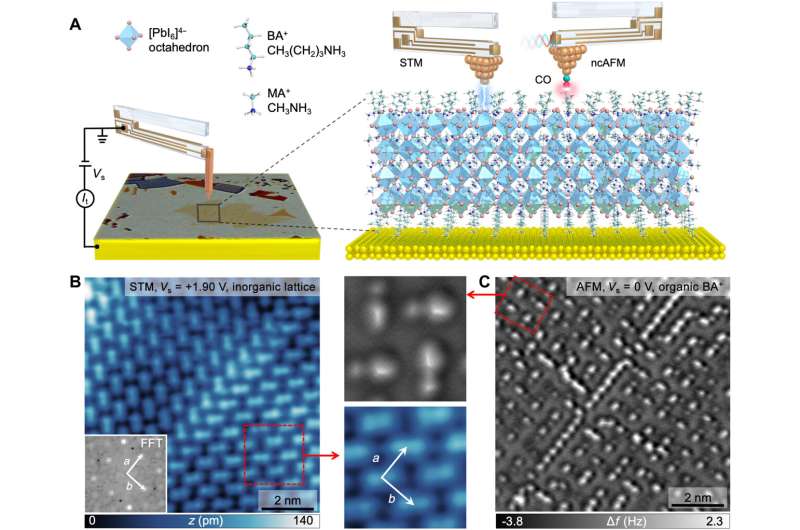
National University of Singapore scientists have demonstrated the non-invasive imaging of both the organic layers and underlying inorganic lattice of two-dimensional (2D) hybrid perovskites at the sub-angstrom level.
The past few years have witnessed a surge of research interest worldwide and rapid growth in the field of 2D Ruddlesden-Popper halide perovskites (RPPs). 2D RPPs are a type of perovskite crystal with novel light-matter interaction and significantly enhanced photo- and chemical stability. They have insulating organic layers sandwiched between conducting inorganic lead-halide frameworks.
However, the insulating nature and softness of the organic layers and the “buried” inorganic framework make the determination of the spatial atomic arrangement and understanding of related effects in 2D RPPs a challenge. Microscopic knowledge of the atomic arrangements in 2D RPPs is still lacking: addressing this aspect is critical not only for fundamental understanding and control of charge, exciton dynamics and other quantum phenomena, but also for their technological applications in photovoltaic and optoelectronic devices.
A NUS research team led by Associate Professor Jiong Lu, in collaboration with Professor Kian Ping Loh’s research group, both from the Department of Chemistry at the National University of Singapore has developed a method for non-invasive imaging of both the top organic layers and their underlying inorganic lattice in 2D RPP at the sub-angstrom scale.
The researchers used a combination of scanning tunneling microscopy (STM) and imaging techniques (Figure 1 A). The STM results provided an atomic reconstruction of the inorganic lead-halide lattice (Figure 1 B), while the tip-functionalized ncAFM imaging enabled a visualization of the top organic layers and its arrangement with respect to the underlaying inorganic lattice at sub-angstrom resolution (Figure 1 C). The reconstruction of the on-surface organic layers, presented by a well-ordered array containing pairs of butylammonium cations, was found to be intimately interlocked with the deformation of the inorganic lattice through hydrogen bonding interactions. This work was jointly undertaken with Prof. Pavel Jelínek from the Institute of Physics, Czech Academy of Sciences.
Using the Kelvin Probe Force Microscopy (KPFM) technique, the team also conducted the atomic-scale imaging of the electrostatic potential variation across the pairs of butylammonium cations. Interestingly, this revealed alternating quasi-one-dimensional (1D) electron and hole channels at neighboring interdomain boundaries. These could potentially allow for long-distance exciton diffusion to enhance the performance of perovskite-based photovoltaic and optoelectronic devices.
Prof Lu said, “Our findings not only bring seminal nanoscale insights on the ground state structure of both organic and inorganic motifs in RPPs, but also shed new light on the mechanism of the efficient separation of photoexcited electron–hole pairs and exciton transport in them.”
More information:
Mykola Telychko et al, Sub-angstrom noninvasive imaging of atomic arrangement in 2D hybrid perovskites, Science Advances (2022). DOI: 10.1126/sciadv.abj0395
Journal information:Science Advances
Provided by
National University of Singapore

READ MORE
How did 168 conquistadors take down the Incan empire?
The Ultimate Family Household Goods Shopping List
A white picket fence isn’t a necessity, but every house needs specific goods to be [...]
A gold electrode fabrication technology that can be combined with thermotherapy technology based on photothermy
Graphical abstract. Credit: ACS Applied Materials & Interfaces (2023). DOI: 10.1021/acsami.3c01160 DGIST Professor Hongki Kang [...]
Real-time imaging shows how SARS-CoV-2 attacks human cells
QD608-RBD binds ACE2 and induces endocytosis. In this figure, the top panel shows ACE2-GFP (yellow) [...]
New optical tweezers can trap large and irregularly shaped particles
Researchers developed contour-tracking optical tweezers that can trap large and irregularly shaped particles such as [...]
New drug-formulation method may lead to smaller pills
MIT chemical engineers have devised a new way to formulate hydrophobic drugs by turning them [...]
Bureaucracy Is Good?
The main plaza of Monte Albán, in the Oaxaca Valley. Building J Public Domain Bureaucrat [...]
Where Clean Drinking Water Is Hard To Find, Bats Could Lead the Way
Long-eared Myotis bat (Myotis septentrionalis), photographed in Arizona. Srikanth Vk, CC BY Desert life depends [...]